Sanjharia, Ajmer Road, Jaipur -302042 INDIA
Check Availability This Room

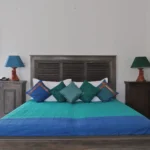
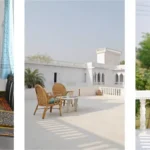
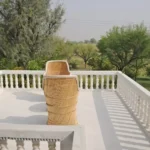
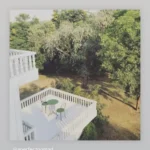
From
$179.0
Night





Pale aquamarine, deep green and brilliant blue soft furnishings,– the hues of the peacock, bird of Rajasthan, from which the room takes its name – complement the traditional Rajasthani muted-green hand-painted furniture in this room. Situated on the first level, the room’s unique feature is two private open terraces that overlook fields of wheat, mustard and pulses, and a large deck overlooking the pool.
The peacock, called Mayura in Sanskrit – pavo cristatus (Linnaeus) – is the national bird of India; it is also the state bird of Rajasthan. Once bred for food, the hunting of peacocks is now banned under the Indian Wildlife Protection Act. In the wild, peacocks live in jungle lands near water, and roost in trees. In Rajasthan, they are also domesticated in villages. The symbolism commonly associated in India with the call of the peacock and its dance with its magnificent feathers fanned out, is the appearance of dark rain-bearing clouds and celebration of the onset of the monsoons.
The term ‘peacock’ is commonly used to refer to birds of both sexes. Technically, only males – large, colorful, swan-sized pheasants with a fan-shaped crest of feathers on the head, white patch under the eye and long slender glistening blue neck and breast and spectacular bronze-green tail of around 200 elongated feathers – are peacocks. The female – brownish, slightly smaller than the male, and lacking the tail – are peahens. Together, they are called peafowl. Suitable males may gather harems of several females, each of which will lay three to five eggs. Peacocks are ground-feeders that eat insects, plants, and small creatures. The two familiar peacock species are the blue peacock that lives in India and Sri Lanka, and the green peacock that is found in Java and Myanmar (Burma).
The special beauty of the peacock lies in its iridescent tail. These tail feathers, or coverts, spread out in a distinctive train that is more than 60 percent of the bird’s total body length, and boast colorful “eye” markings of blue, gold, red, and other hues. The large train is used in mating rituals and courtship displays. It can be arched into a magnificent fan that reaches across the bird’s back and touches the ground on either side. Females are believed to choose their mates according to the size, color, and quality of these outrageous feather trains.
Behind the stunningly beautiful plumage of the peacock lies a complex structure that changes color with the angle of incident light. The diversity of bird feathers’ colors can generally be explained by just two factors: pigments, and simple structures in the feathers that interfere with incident light. In the case of the peacock, pigment particles are embedded into the newly grown feathers during the molting season. They absorb light of certain wavelengths, or disperse the reflected light, and so contribute to the color of the plumage. The vivid colors of a peacock feather, however, do not arise entirely from pigments. In fact, according to investigations by scientists at the Fudan University in Shanghai, the role of pigments may be minimal, and it is the structure of the feather that plays a major role in the color. Each feather consists of thousands of flat branches. When light shines on the feather, we see thousands of glimmering colored spots, each caused by minuscule bowl-shaped indentations. Stronger magnification reveals microscopic lamellae (thin plate-like layers) at the bottom of the indentations. As with butterfly wings, the regular pattern of the lamellae leads to interference phenomena and iridescent colors. The feathers of pheasants, birds of paradise, and hummingbirds, all create color using the same mechanism.
Almost all the major ancient cultures revered the peacock, which symbolized for them, variously, glory, vision, royalty, spirituality, awakening, wisdom and immortality. In Hinduism, Indra the god of thunder, rains and war, is depicted in the form of a peacock. In south India, the peacock is the ‘vahana‘ or vehicle of Lord Muruga, the son of Shiva. The peacock is also associated with both Lakshmi and Sarawati, the goddesses who between them represent grace, benevolence, patience, kindness, compassion, knowledge, wisdom and good luck. The figure of the peacock can also be found painted on various Islamic religious buildings.
A tiny group of peacocks and peahens have chosen recently to take up residence in the Savista grounds. They can be occasionally sighted around the haveli. Despite having prospected the place over two years before deciding to settle, they continue to be fascinated (and intrigued) by the haveli, particularly its glass doors in which they can see their own reflections!
Check-in/check-out: 12 noon.
For availability and reservations, please write directly to [email protected].
Main features:
Stunning, uniquely-designed, airy rooms with plenty of natural light and views of greenery all around.
Carefully selected handmade / restored Rajasthani furniture and artifacts, or a blend of traditional and modern furniture.
Very comfortable beds for the best possible sleep.
Restored colonial / traditional Indian / contemporary writing desk in most rooms.
Every room has either a sun terrace, or an additional glass-enclosed sitting room / patio with gorgeous views of the outdoors, or an attached balcony overlooking the pool. A few have fireplaces.
Room and bathroom windows can be opened to let in fresh air when preferred.
All bathrooms are ensuite, have hot and cold running water and rain showers, and views of tree-tops.
Facilities:
- Complimentary breakfast;
-
Tea / Coffee making facility;
-
Pure, natural drinking water from Savista’s borewells (complimentary bottled water on request);
-
Complimentary nibbles;
- Free wireless internet;
- Air conditioning;
- Space heating in chilly weather;
- Sumptuous duvet and high quality cotton bed linen;
- Hundred percent cotton towels, robes and room slippers;
- Branded herbal bath products.
Other Facilities:
- Business services (scanning, copying, printing);
- Laundry and ironing*;
- Hair dryer;
- Concierge service;
- Maps and travel guides;
- Medicines, germicide gargle, sewing accessories etc. (an “Ask For” menu is placed in each room. If you require some other service that is not listed, please ask and we will try our best to arrange it for you);
- Doctor/dentist appointments and facilitation;
- For guests with physical disabilities, one room can be outfitted to suit their needs. Please let us know when booking.
(* chargeable)
N.B.
Most rooms feature a large double bed (king-size), and are for single/double occupancy;
Five rooms can be adapted into twin-bedded rooms (please let us know when you are specifically looking for a twin room;
A child below 4 stays free if sharing the parents’ bed;
Children of 4 and above require an extra bed. Four of our rooms can accommodate an extra rollaway bed (for a child only) for a small extra charge. Please email us with your requirement and we will help you make your selection;
All our guest rooms are non-smoking;
We are a pet-free property;
We do not have T.V.s or intercoms in the rooms;
We accept Visa and Master credit cards, Bank to bank transfers and cash payments (we do not accept Amex cards).
No hidden costs: No resort fees and other vague charges; No workout charges; No towel replacement costs; No wi-fi costs; No parking fees; No breakfast bills.
Be the first to review “Mayura”
You must be logged in to post a comment.
Regular plan
| Mon | Tue | Wed | Thu | Fri | Sat | Sun |
|---|---|---|---|---|---|---|
| $179.0 | $179.0 | $179.0 | $179.0 | $179.0 | $179.0 | $179.0 |

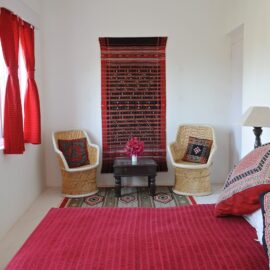
Reviews
There are no reviews yet.